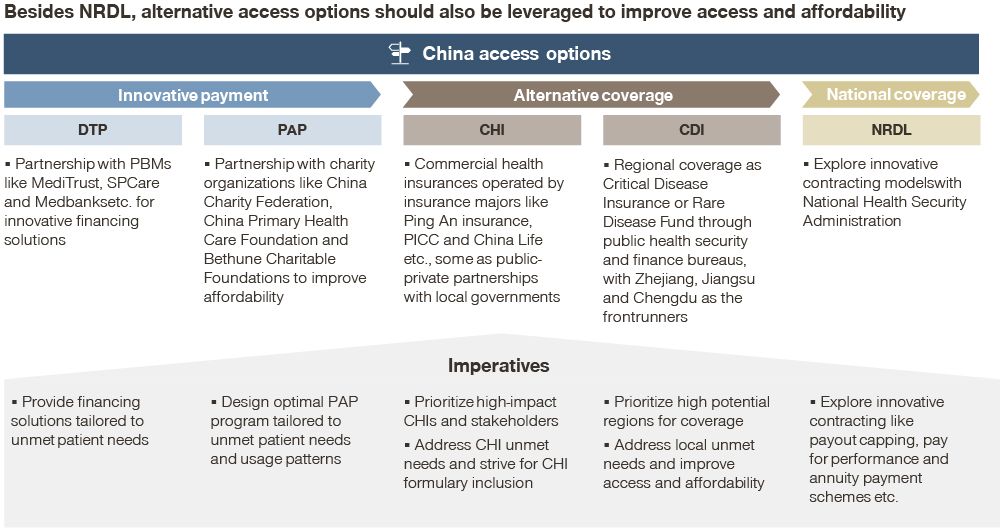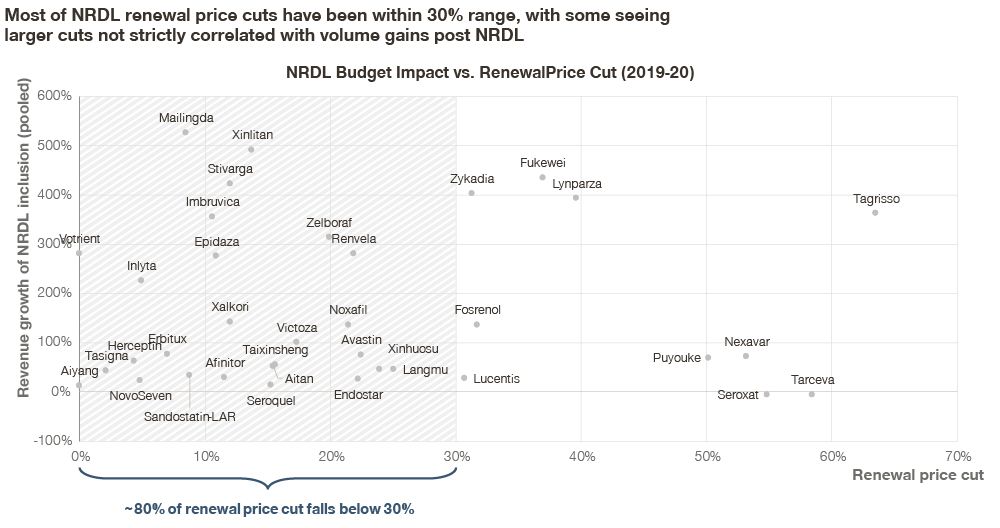China 2021 National Reimbursement Drug List Outlook
The 2021 National Reimbursement Drug List (NRDL) process has been unfolding in China since June this year, with several key themes emerging. Building on Simon-Kucher’s experience with the NRDL, the authors make three recommendations on negotiation strategies going into the process.
The National Reimbursement Drug List (NRDL) is the major mechanism for public reimbursement in China, covering 98 percent of the entire population. Its formulary has been updated on a yearly basis since 2017, currently standing at 2,800 inclusions, compared to 2,588 in 2017.
Most innovative drugs would strive to be included in the NRDL for the 70-80 percent coverage it affords. This has long been considered the primary driver for pursuing the listing. At the same time, NRDL inclusions typically come with significant price cuts, which, on average, stood at 61 percent in 2019, and 51 percent in 2020.
What are 2021 NRDL themes?
The 2021 NRDL has been unfolding with three key themes emerging: increasing transparency, ongoing emphasis on innovations, and more openness for high-priced therapies.
Increasing transparency
- In June 2021, the National Health Security Administration (NHSA) released a five-stage process laying out the timeline and work plan for this year’s update, soliciting submissions for “formal reviews” from the industry to get started
- By the end of July, the NHSA announced that 271 of the 474 submissions had passed the formal review process
- More importantly, for the first time in history, the submission materials of the 271 successful applications were made public, with information along six key categories on: basic info, reference drugs, efficacy, safety, innovation, and equity, which would all be the key inputs for shortlisting, expert reviews, and upcoming negotiations
Ongoing emphasis on innovations
- Of the 271 entries that passed formal review, 99 were already in the NRDL’s formulary and up for renewals this year
- While 172 are new entries, of which 93 drugs have already been newly approved since 2020 accounting for 57 percent of the new entries
- In particular, 15 of the new entries were freshly approved in the first half of 2021, including the first CAR-T therapy, Yescarta, approved in China one week before the 2021 NRDL started, as well as multiple innovative drugs across diverse therapeutic areas: oncology, cardiovascular, diabetes, infectious diseases, and rare diseases
More openness for high-priced therapies
- Many high-priced therapies wouldn’t typically be considered for NRDL in previous years, but have made their way to this year’s formal review and shortlisting processes
- This is an encouraging sign for the industry, as well as for healthcare practitioners, and, mostly importantly, for patients in need
What are Simon-Kucher’s three recommendations?
As the 2021 NRDL cruises into the final stage of price negotiations, we have developed three recommendations tailored to new launches, high-priced therapies, and renewals, respectively.
1. Fast NRDL inclusion is key for new launches
Click to enlarge.

- Simon-Kucher analysis based on NRDL outcomes from recent years shows that, NRDL inclusions typically bring positive impacts despite significant price cuts
- Moreover, the faster NRDL inclusions, the larger revenue impacts. The impacts also tend to be disproportionate and exponential to the inclusion timeline
- Zykadia, for example, was included into the NRDL within 7 months of its China launch, which resulted in 641 percent revenue growth the year after, driven mainly by speedy access combined with improved affordability. In comparison, Xalkori was listed 71 months after launch, with revenue impact at just over 100 percent, driven more by affordability than access
- Market access has always represented multiple hurdles for new drugs in China, ranging from provincial tendering, hospital listing, to formulary constraints, and drug cost ratio control, etc
- NRDL inclusion helps overcome many of these access barriers, sometimes in one fell swoop. The positive impact from speedy access has far outweighed the affordability factor in recent NRDL inclusions, as seen in the Zykadia versus Xalkori case
2. Alternative access is important for high-priced therapies
Click to enlarge.

- China’s access environment is dynamic and changing fast, with alternative pathways like Direct to Patient (DTP) financing, Critical Disease Insurances (CDI), and Commercial Health Insurances (CHI) playing increasingly important roles in improving access and affordability
- City CHIs, in particular, have taken off across 200 cities, with formularies tailored to local unmet needs, and demonstrating an increasing openness to innovative therapies like biologics, CAR-T, and rare disease drugs alike.
- The traction gained with HCPs and patients through alternative access pathways, as well as the goodwill and real world evidence accumulated through the process, can help to further strengthen the value dossiers for NRDL
- Success with innovative access may serve as supporting evidence for NRDL negotiation, and as a fallback option as needed. By proactively exploring opportunities in alternative access, innovative therapies will be better equipped going into NRDL negotiations
3. Emphasis on value over price for NRDL renewals:
- Many renewals would expect additional price cuts, especially if the sales post NRDL inclusion significantly exceed the committed Budget Impact Analysis (BIA) targets aligned with the NHSA. Moreover, the risk of no-renewals always hangs like the sword of Damocles — upping the ante for renewal negotiations
- Simon-Kucher analysis, based on NRDL renewal outcomes from recent years, indicated that most of the NRDL renewal price cuts have been within a 30 percent range. While there are some outliers with larger cuts in the past, the cut magnitudes did not strictly correlate with the volume gains post NRDL
Click to enlarge.

- For renewal failures, on the other hand, the outcomes were not typically a direct result of volume gains, but declined clinical value and superior substitutes newly included in the NRDL
- Based on these findings, we suggest framing renewal negotiations around value over price, or volume gain. In fact, volume gain should be used as evidence of the unique value it brings, instead of the proof of guilt
- With additional evidence on the clinical and economic value, one would be well-equipped going into NRDL negotiations without giving away too much on the renewal price
Key takeaways
The NRDL will continue to shape China’s pharma and healthcare industry going forward. The 2021 process has been unfolding with new themes and implications, and we expect to see some breakthroughs for fast inclusions and high-priced therapies this year. Pharmaceutical companies would need to closely follow the latest NRDL trends, plan for different scenarios, and tailor their strategies accordingly to maximize NRDL opportunities for their portfolios.
About the authors
Bruce Liu leads Simon-Kucher’s Life Sciences division in Greater China. Shiyi He is a consultant with extensive experience in health economics and payer strategies in China. Ivy Jiang is a consultant with years of experience in China pharmaceutical pricing and access strategies. Duo Xu is a consultant specialized in China pharma and healthcare industry with recent experience on NRDL renewals. Selene Peng is a consultant with experience across diverse therapeutic areas, and recent experience on NRDL trends and outlook.